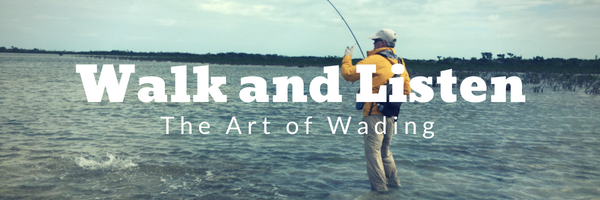Wading is the perfect exercise for those who enjoy the hunting aspect of bonefishing.
Searching for cruising bones while wading the flats will test your stealth, your vision, and your listening abilities. When done properly, wading can be a very delicate and effective way to land your prey. Following are several tips to help you prime your wading skills for success.
Determine Your Ideal Wading Depth
When traveling together, most bonefish tend to cruise at the same, approximate depth. This may be the depth at which they feel the safest. When you begin spotting bones, take stock of how deep you’re actually standing in the water. The water might be just above the tops of your boots, at your shins, or skimming your knees. Once you’ve identified the ideal depth for wading, you can follow it until your casting arm grows tired.
Be Quiet
Practice lifting and lowering your boots with finesse. You certainly don’t want to take big, stomping steps that create a ton of water disturbance and produce a lot of noise. Bones can pick up on and respond to any vibrations and noises that you make at a considerable distance. Rather than sloshing your way through the flats, make each step a careful and concise movement. Lift each foot up out of the water and lower it down vertically while making sure to land on the balls of your feet, rather than the heels. You also want to make sure that your wading boots are comfortable, well-made, and designed specifically for traversing flat bottoms.
Survey The Area
When wading, you don’t have to be in constant motion. You can count on bonefish to maintain continuous movement for you, which means that they’ll eventually come closer if you don’t scare them off first. Take a number of rests during your search and spend time studying the water for evidence of bonefish movement. Also, be sure to check out the sky as well. Moving clouds can temporarily block the light right when you’re in a prime position. Fast-moving clouds will allow you to hold your ground until the natural light is restored. If you march off too quickly, you may scare away your prey and miss the opportunity for a prime catch.
Listen
Even though bonefish are well-known for their stealth, their tailing and feeding activities aren’t always that quiet. In fact, when you’re wading, you’ll quickly grow adept at picking up on the auditory evidence of their nearby movements. Wading is a much more intimate experience than fishing from the boat, given that you’re actually sharing their environment with them. As such, it gives you the best ability to use your listening skills to make up for what you cannot see. If you aren’t noisily splashing your way through the water, you’ll able to pick up on the noises that bones make when searching for and consuming their meals.









